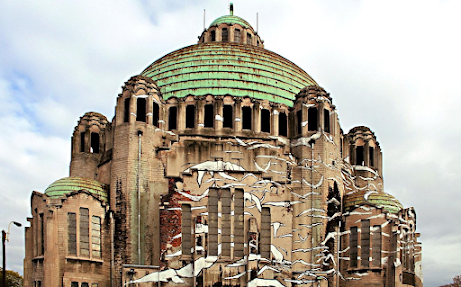One church after another closing. Rome synods while the church burns.
The Basilica at Cointe has been transformed into a climbing centre, the church at Bouhay into a shelter for women in distress, the chapel of Notre-Dame-en-Chemin at Boncelles into offices, housing is planned for the parish of Saint-Lambert de Soumagne or the former monastery at Chèvremont. There is no shortage of examples of changes in the use of religious sanctuaries in the Liège region, not to mention the hypothesis of a museum at Saint-Pholien in Outremeuse. For Saint-Pierre in Saive or Saint-Antoine-l'Hermite in Queue-du-Bois, discussions are underway. The buildings sometimes belong to congregations, but often they are public property, and desacralisation operations require communal or regional authorisations. The bishopric does not control all the elements to prevent a buyer from doing anything. But it tries to preserve the dignity of these places. This often means sharing with other Christians: the Syriacs at Saint-Simon-des-Oliviers in Herstal, the Greek Orthodox at Saint-Jean-Baptiste in Verviers, the Georgians at the chapel of Calvary in Laveu, and even the evangelists at Oblasts.
There is a heritage to be preserved there, but the heating and maintenance costs of almost empty and often poorly insulated buildings are highly displeasing to the local authorities. The pressure to close is growing. However, in this episode in Liège en Prime, the episcopal vicar of Beukelaer played the role of conciliation, temporisation and negotiation. A real estate policy full of nuances.
Promotion for Belgian radio programme. An interview with the Vicar General in French.
The Fate of the Basilica that was never a Basilica
The Basilica of Peace Foundation has made its choice among the three projects selected last October for the rehabilitation of the "basilica" of Cointe. It was the project led by the Gehlen Group in association with the company The Wall.
The 'basilica' of Cointe has never actually received this title. It is the church of the Sacred Heart and Our Lady of Lourdes. It was built on the site of the Inter-Allied Memorial. It was deconsecrated in 2010 and has been listed since 2011. It was waiting for a new use.
Its current owner, the Fondation Basilique de la Paix, had launched a call for projects. It will lead to the implementation of a project called "Basilica Experience". It will offer various activities based on climbing. The Gehlen Group wanted to take advantage of the building's 40-metre high ceiling. In association with the company The Wall, which already has a climbing hall on the Intermills site in Malmedy, it will build what will be the highest climbing hall in Europe. It will be completed by a tree climbing course.
An extension will be added to the current building to accommodate a panoramic restaurant, a local cinema and a multi-purpose area. It is also planned to create bubbles attached to the Basilica's dome for people wishing to spend a night in atypical accommodation.
The choir of the church will be preserved and will host a memorial space. The crypt and sacristy will retain their religious vocation.The promoters of the project hope to start work in mid-2023.
Church becomes shelter
The project is still very discreet, but it seems very serious: this former church, which belonged to a congregation and not to the diocese, which was sold a quarter of a century ago to a property developer and then put up for sale again three years ago, is going to become a shelter for women in difficulty. The configuration of the premises obviously allows for this kind of transformation: the building, built on the side of a hill, rests on a crypt, in fact a vast "basement", a room with windows where rooms or dormitories can be set up without the height of the nave posing a problem. The presbytery should be rehabilitated into three flats for retired priests.
In addition to the new use, the file reveals other particularities. The new owners are a public utility foundation whose mission is the restoration of movable or immovable religious property. It has existed for about fifteen years. It was launched in the orbit of a Liege company, Ateliers François, a manufacturer of piston compressors, which made its fortune thanks to plastic bottle blowing machines for mineral water factories. It is the world leader in its sector and its machines can be found on all five continents.
The Ateliers François is a family business, the Rolin Jaequemyns and not just any family, since it has already given the country at least two ministers of the interior, several eminent jurists, and some successful industrialists, and even... advisors to the Thai court. The current boss of Ateliers François is in fact a consul of that kingdom. The foundation that he directs seems determined to put its social commitment into practice locally.
















.jpeg)

Comments